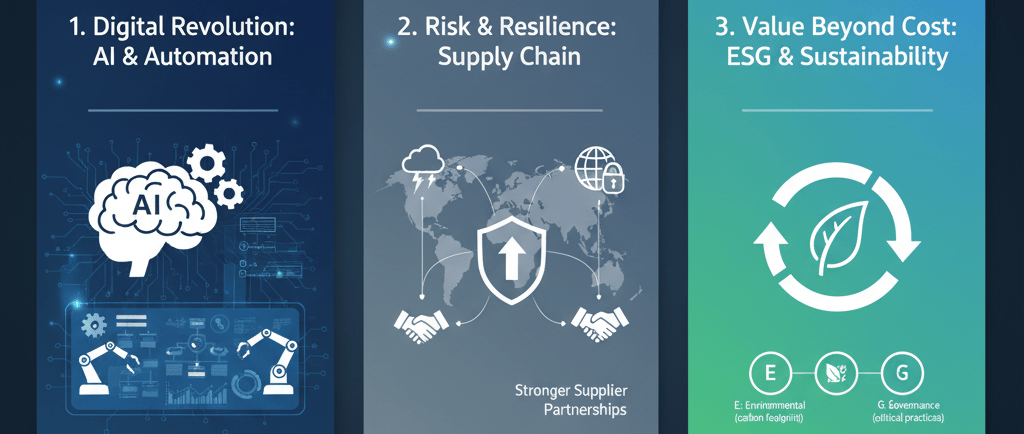The Three Pillars of Modern Procurement
7/8/20252 min read


The shifts in the global landscape—from supply chain disruptions and geopolitical volatility to the urgent call for sustainability—have forced procurement leaders to rethink their strategies. Here are the three non-negotiable areas defining the new era:
1. The Digital Revolution: AI and Automation
The days of paper trails and endless spreadsheet management are rapidly fading. Technology is no longer a "nice-to-have" but the foundational engine for modern procurement.
Artificial Intelligence (AI) and Generative AI (GenAI): These tools are moving beyond simple automation. AI-powered platforms can now analyze vast amounts of spend data in real-time, predict supply chain disruptions, recommend optimal sourcing strategies, and even automate the drafting of RFPs (Requests for Proposal). This frees up procurement professionals to focus on strategic tasks that require human judgment and negotiation.
End-to-End Digitalization: The goal is seamless, interconnected processes—from spend analysis and e-sourcing to contract management and invoice processing. Digital tools ensure compliance, improve speed, and provide the 360-degree visibility needed to make rapid, data-driven decisions.
2. Risk and Resilience: Building a Future-Proof Supply Chain
Global events have highlighted the fragility of overly lean, single-source supply chains. Resilience is now as important as cost savings.
Proactive Risk Management: Modern procurement involves continuous monitoring of geopolitical shifts, natural disaster threats, and the financial health of all suppliers (not just Tier 1). It's about developing robust scenario planning and having a playbook ready for any disruption.
Strategic Sourcing and Diversification: Procurement teams are actively moving away from single-source reliance, embracing dual-sourcing and regionalization. This diversification is the ultimate insurance policy against unexpected shocks, ensuring the continuity of critical supply.
Stronger Supplier Partnerships: The relationship with suppliers is shifting from purely transactional to deeply collaborative. When you treat a supplier as a strategic partner, you gain access to their innovation, secure priority during shortages, and build a more reliable, mutual-value-driven network.
3. Value Creation Beyond Cost: ESG and Sustainability
For years, procurement's primary metric was "cost savings." Today, that metric has expanded to "total value creation," with Environmental, Social, and Governance (ESG) factors at the core.
Sustainable Sourcing as a Mandate: Stakeholders—from investors and regulators to consumers—demand that companies demonstrate social and environmental responsibility. Procurement is the function best positioned to deliver this. This means vetting suppliers for their ethical practices, labor standards, and carbon footprint (especially Scope 3 emissions).
The Circular Economy: Procurement plays a crucial role in enabling a circular model by sourcing goods that are recyclable, supporting remanufacturing, and managing the end-of-life process for products.
Compliance with New Regulations: New mandates around the globe (like the EU's Corporate Sustainability Due Diligence Directive) are turning voluntary sustainable practices into legal obligations, making compliance a key procurement responsibility
